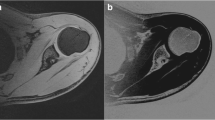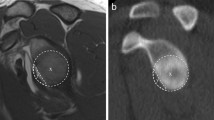Abstract
Objective
To compare MRI with 3D reconstructions and 3D-CT with respect to assessment of glenoid wear in osteoarthritic shoulders.
Methods
3D reconstructions were generated for CT and MR (utilizing the Dixon technique) imaging performed on 29 osteoarthritic shoulders. Two reviewers independently performed glenoid morphometric measurements and evaluated glenoid erosion. Mean differences between the two modalities were calculated. Inter-observer agreement was calculated using kappa coefficient.
Results
The combined mean absolute difference (bias) in glenoid version between 3D-CT and 3D-MRI was 2.7° ± 1.6° (range 0.15–7.85, P value = 0.7). The combined mean absolute difference in glenoid inclination between 3D-CT and 3D-MRI was 6.8° ± 4.1° (range 0.8°–15.75°, P value = 0.17). No significant inter-reader variation in glenoid version and inclination measurements on 3D-CT and 3D-MRI was found (P > 0.05). The inter-reader reliability for both CT and MRI was high for Walch grading of glenoid bone loss (κ = 1, κ = 0.81, respectively).
Conclusions
3D-MRI is comparable to 3D-CT with respect to axial glenoid bone loss, as measured by glenoid version. However, for coronal bone loss estimation, measured by glenoid inclination, 3D-CT remains the gold standard. Thus, 3D-MR can be used as an alternative for preoperative assessment of glenoid version in arthritic shoulders.





Similar content being viewed by others
References
Boileau P, Cheval D, Gauci MO, Holzer N, Chaoui J, Walch G. Automated three-dimensional measurement of glenoid version and inclination in arthritic shoulders. J Bone Joint Surg Am. 2018;100:57–65.
Collins D, Tencer A, Sidles J, Matsen F III. Edge displacement and deformation of glenoid components in response to eccentric loading. The effect of preparation of the glenoid bone. J Bone Joint Surg Am. 1992;74:501–7.
Farron A, Terrier A, Buchler P. Risks of loosening of a prosthetic glenoid implanted in retroversion. J Shoulder Elbow Surg. 2006;15:521–6.
Walch G, Mesiha M, Boileau P, et al. Three-dimensional assessment of the dimensions of the osteoarthritic glenoid. Bone Joint J. 2013;95-b:1377–82.
Ho JC, Sabesan VJ, Iannotti JP. Glenoid component retroversion is associated with osteolysis. J Bone Joint Surg Am. 2013;95: e82.
Kopka M, Fourman M, Soni A, Cordle AC, Lin A. Can glenoid wear be accurately assessed using X-ray imaging? Evaluating agreement of X-ray and magnetic resonance imaging (MRI) Walch classification. J Shoulder Elbow Surg. 2017;26:1527–32.
Walch G, Badet R, Boulahia A, Khoury A. Morphologic study of the glenoid in primary glenohumeral osteoarthritis. J Arthroplasty. 1999;14:756–60.
Bokor DJ, O’Sullivan MD, Hazan GJ. Variability of measurement of glenoid version on computed tomography scan. J Shoulder Elbow Surg. 1999;8:595–8.
Kwon YW, Powell KA, Yum JK, Brems JJ, Iannotti JP. Use of three-dimensional computed tomography for the analysis of the glenoid anatomy. J Shoulder Elbow Surg. 2005;14:85–90.
Fitzgerald M, Lawler SM, Lowe JT, Nelson R, Mantell MT, Jawa A. Computed tomography underestimates rotator cuff pathology in patients with glenohumeral osteoarthritis. J Shoulder Elbow Surg. 2018;27:1451–5.
Iordache SD, Goldberg N, Paz L, Peylan J, Hur RB, Steinmetz A. Radiation exposure from computed tomography of the upper limbs. Acta Orthop Belg. 2017;83:581–8.
Lansdown DA, Cvetanovich GL, Verma NN, et al. Automated 3-dimensional magnetic resonance imaging allows for accurate evaluation of glenoid bone loss compared with 3-dimensional computed tomography. Arthroscopy. 2019;35:734–40.
Vopat BG, Cai W, Torriani M, et al. Measurement of glenoid bone loss with 3-dimensional magnetic resonance imaging: a matched computed tomography analysis. Arthroscopy. 2018;34:3141–7.
Stillwater L, Koenig J, Maycher B, Davidson M. 3D-MR vs. 3D-CT of the shoulder in patients with glenohumeral instability. Skeletal Radiol. 2017;46:325–31.
Gyftopoulos S, Beltran LS, Yemin A, et al. Use of 3D MR reconstructions in the evaluation of glenoid bone loss: a clinical study. Skeletal Radiol. 2014;43:213–8.
Gyftopoulos S, Yemin A, Mulholland T, et al. 3DMR osseous reconstructions of the shoulder using a gradient-echo based two-point Dixon reconstruction: a feasibility study. Skeletal Radiol. 2013;42:347–52.
Friedman RJ, Hawthorne KB, Genez BM. The use of computerized tomography in the measurement of glenoid version. J Bone Joint Surg Am. 1992;74:1032–7.
Maurer A, Fucentese SF, Pfirrmann CW, et al. Assessment of glenoid inclination on routine clinical radiographs and computed tomography examinations of the shoulder. J Shoulder Elbow Surg. 2012;21:1096–103.
Bercik MJ, Kruse K II, Yalizis M, Gauci MO, Chaoui J, Walch G. A modification to the Walch classification of the glenoid in primary glenohumeral osteoarthritis using three-dimensional imaging. J Shoulder Elbow Surg. 2016;25:1601–6.
Landis JR, Koch GG. The measurement of observer agreement for categorical data. Biometrics. 1977;33(1):159–74.
Karelse A, Van Tongel A, Van Isacker T, Berghs B, De Wilde L. Parameters influencing glenoid loosening. Expert Rev Med Devices. 2016;13(8):773–84. https://doi.org/10.1080/17434440.2016.1205483.
Samim M, Eftekhary N, Vigdorchik JM, Elbuluk A, Davidovitch R, Youm T, Gyftopoulos S. 3D-MRI versus 3D-CT in the evaluation of osseous anatomy in femoroacetabular impingement using Dixon 3D FLASH sequence. Skeletal Radiol. 2019;48(3):429–36.
Samim M. 3D MRI models of the musculoskeletal system. Semin Musculoskelet Radiol. 2021;25(3):388–96.
Breighner RE, Endo Y, Konin GP, Gulotta LV, Koff MF, Potter HG. Technical developments: zero echo time imaging of the shoulder: enhanced osseous detail by using MR imaging. Radiology. 2018;286(3):960–6.
de Mello RAF, Ma YJ, Ashir A, et al. Three-dimensional zero echo time magnetic resonance imaging versus 3-dimensional computed tomography for glenoid bone assessment. Arthroscopy. 2020;36:2391–400.
De Filippo M, Bertellini A, Sverzellati N, Pogliacomi F, Costantino C, Vitale M, Zappia M, Corradi D, Garlaschi G, Zompatori M. Multidetector computed tomography arthrography of the shoulder: diagnostic accuracy and indications. Acta Radiol. 2008;49(5):540–9. https://doi.org/10.1080/02841850801935559.
Author information
Authors and Affiliations
Corresponding author
Ethics declarations
This prospective controlled study was approved by the Institutional Review Board of the Ethical Committee (i17-00500).
Additional information
Publisher's note
Springer Nature remains neutral with regard to jurisdictional claims in published maps and institutional affiliations.
Rights and permissions
About this article
Cite this article
Rosenthal, Y., Samim, M., Gyftopoulos, S. et al. 3D-MRI versus 3D-CT in the evaluation of glenoid deformity in glenohumeral arthritis using Dixon 3D FLASH sequence. Skeletal Radiol 51, 2281–2289 (2022). https://doi.org/10.1007/s00256-022-04086-6
Received:
Revised:
Accepted:
Published:
Issue Date:
DOI: https://doi.org/10.1007/s00256-022-04086-6




